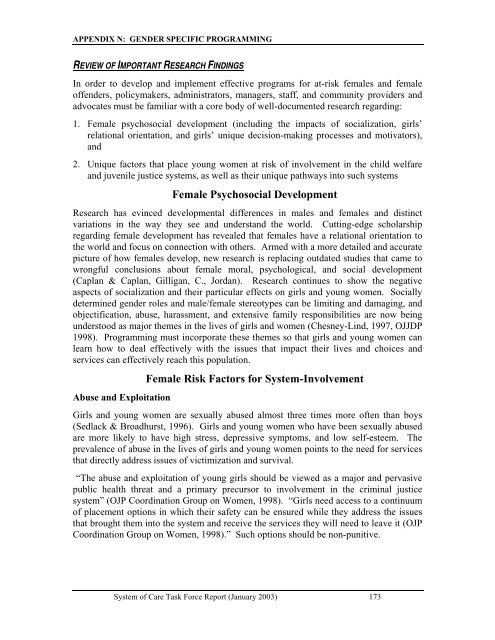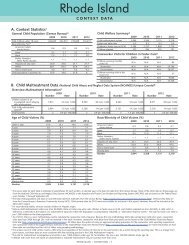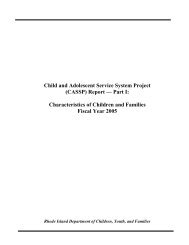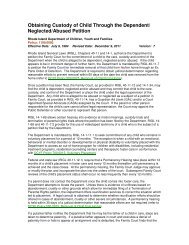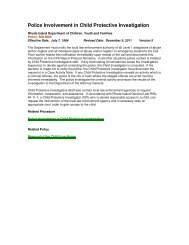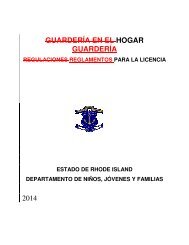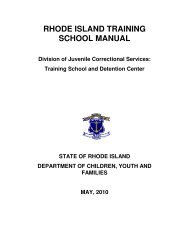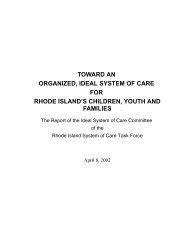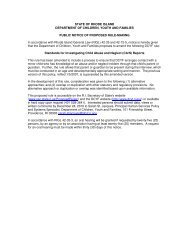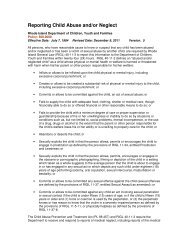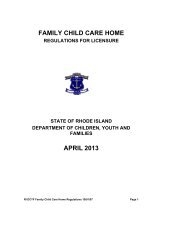Final Report - RI Department of Children, Youth & Families
Final Report - RI Department of Children, Youth & Families
Final Report - RI Department of Children, Youth & Families
Create successful ePaper yourself
Turn your PDF publications into a flip-book with our unique Google optimized e-Paper software.
APPENDIX N: GENDER SPECIFIC PROGRAMMING<br />
REVIEW OF IMPORTANT RESEARCH FINDINGS<br />
In order to develop and implement effective programs for at-risk females and female<br />
<strong>of</strong>fenders, policymakers, administrators, managers, staff, and community providers and<br />
advocates must be familiar with a core body <strong>of</strong> well-documented research regarding:<br />
1. Female psychosocial development (including the impacts <strong>of</strong> socialization, girls’<br />
relational orientation, and girls’ unique decision-making processes and motivators),<br />
and<br />
2. Unique factors that place young women at risk <strong>of</strong> involvement in the child welfare<br />
and juvenile justice systems, as well as their unique pathways into such systems<br />
Female Psychosocial Development<br />
Research has evinced developmental differences in males and females and distinct<br />
variations in the way they see and understand the world. Cutting-edge scholarship<br />
regarding female development has revealed that females have a relational orientation to<br />
the world and focus on connection with others. Armed with a more detailed and accurate<br />
picture <strong>of</strong> how females develop, new research is replacing outdated studies that came to<br />
wrongful conclusions about female moral, psychological, and social development<br />
(Caplan & Caplan, Gilligan, C., Jordan). Research continues to show the negative<br />
aspects <strong>of</strong> socialization and their particular effects on girls and young women. Socially<br />
determined gender roles and male/female stereotypes can be limiting and damaging, and<br />
objectification, abuse, harassment, and extensive family responsibilities are now being<br />
understood as major themes in the lives <strong>of</strong> girls and women (Chesney-Lind, 1997, OJJDP<br />
1998). Programming must incorporate these themes so that girls and young women can<br />
learn how to deal effectively with the issues that impact their lives and choices and<br />
services can effectively reach this population.<br />
Abuse and Exploitation<br />
Female Risk Factors for System-Involvement<br />
Girls and young women are sexually abused almost three times more <strong>of</strong>ten than boys<br />
(Sedlack & Broadhurst, 1996). Girls and young women who have been sexually abused<br />
are more likely to have high stress, depressive symptoms, and low self-esteem. The<br />
prevalence <strong>of</strong> abuse in the lives <strong>of</strong> girls and young women points to the need for services<br />
that directly address issues <strong>of</strong> victimization and survival.<br />
“The abuse and exploitation <strong>of</strong> young girls should be viewed as a major and pervasive<br />
public health threat and a primary precursor to involvement in the criminal justice<br />
system” (OJP Coordination Group on Women, 1998). “Girls need access to a continuum<br />
<strong>of</strong> placement options in which their safety can be ensured while they address the issues<br />
that brought them into the system and receive the services they will need to leave it (OJP<br />
Coordination Group on Women, 1998).” Such options should be non-punitive.<br />
System <strong>of</strong> Care Task Force <strong>Report</strong> (January 2003) 173


